Data-driven decisions are only as good as the data behind them. But when your tools don’t talk to each other, insight turns into a puzzle. Manual work piles up, reports lag behind reality, and leaders never have a clear view of what is actually happening. The cost of siloed systems is wasted time, inconsistent data, and missed opportunities.
Salesforce is the worldwide CRM leader covering tasks from customer relationship management and tracking sales to organizing data pipeline and reporting. Power BI is Microsoft’s business intelligence platform that helps teams visualize and analyze data to spot trends and make smarter calls. These tools are powerful on their own. Together, they turn raw CRM inputs into real-time insights. Connecting Power BI to Salesforce gives you a unified, automated view of performance.
In this article, we’ll break down how to connect Power BI to Salesforce using various tools from native to third-party options. You’ll get step-by-step instructions, a comparison of connection methods, key benefits of integration, and specifics to keep in mind.
Benefits of Power BI and Salesforce Integration
Bringing Salesforce and Power BI together transforms how your business sees and uses data. Here’s how this integration creates real impact.

Holistic Data Analysis
Power BI enables you to bring in Salesforce data along with other sources like marketing platforms, ERP systems, and customer service tools. The result is an end-to-end picture of your company from lead to loyalty. Instead of disconnected reports, you have a single view that enables departments to communicate, providing the entire customer journey and showing how each component of your operation generates value.
Advanced and Interactive Visualizations
Salesforce reports are good enough. Power BI takes it one step further. You can drill down into your data with visual, interactive dashboards and dynamic filtering. See trends, track KPIs, and compare performance by regions or teams with the click of a button.
Real-Time Insights
With automatic data refresh, your dashboards stay up to date without the need for manual export. That implies you're always working with up-to-date insights. From tracking sales performance to detecting pipeline bottlenecks, you can respond faster and stay ahead of the curve.
Errors Elimination and Saved Time
Manual entry of data is risky. Integration provides seamless, automated workflows that synchronize data and make it accurate. No longer missed updates, no longer duplicates, no longer spreadsheet headaches and human error.
Better Customer Experience
When your team has access to precise, real-time data, they can act with confidence. Marketing knows what’s working. Sales knows where to focus. Leadership sees the bigger picture. And customers get faster responses, more personalized interactions, and smoother journeys overall.
7 Methods to Connect Power BI to Salesforce
There are many ways to connect Power BI to Salesforce. Some use native tools, while others use third-party solutions. The main point is that most of these methods are rather demanding and challenging, requiring time and effort to configure.
Below, we review the most popular and widely used integration methods:
Method 1: The Native Power BI Salesforce Objects Connector
The Object connector is one of the built-in connectors in Power BI. It is the easy and direct way to bring CRM data to the BI platform. This method is quick to set up and doesn’t require any third-party tools. However, you’ll need an active Salesforce account with API access enabled, which typically comes with Salesforce Enterprise edition or higher.
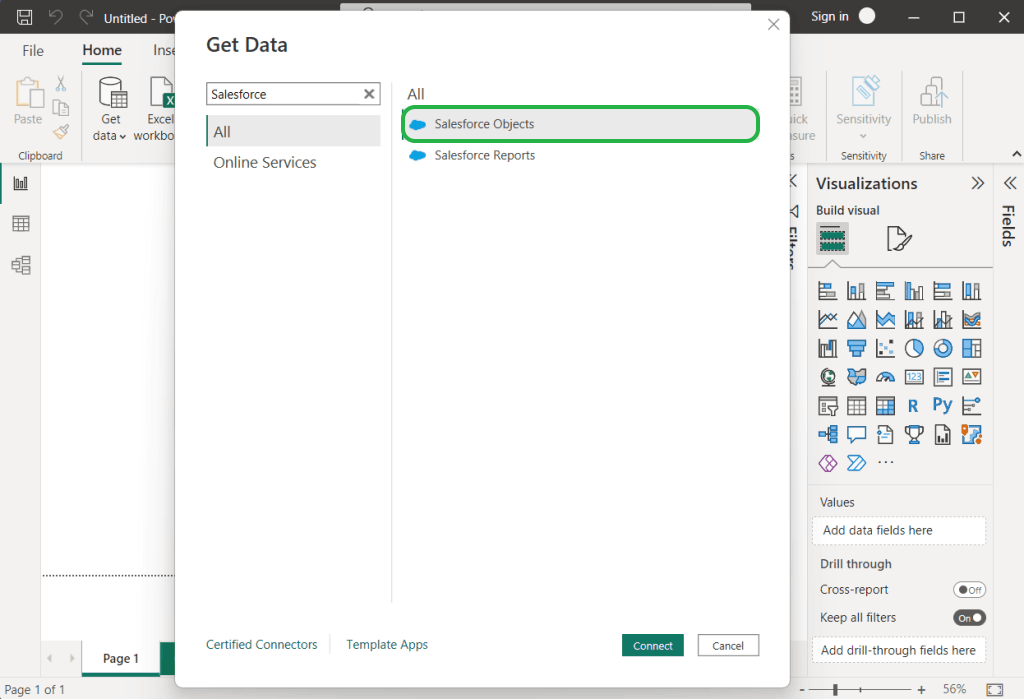
Who It’s For
- Users who want direct access to Salesforce's underlying data structure.
- Teams that need to combine Salesforce data with other sources in Power BI.
- Users who are comfortable with building custom data models instead of relying on prebuilt reports.
Step-by-Step Instructions
Follow these steps to perform integration with Salesforce Objects:
- Open Power BI and click Get Data.
- From the search box, type Salesforce and select Salesforce Objects.
- Choose between Production and Custom.
- Open Salesforce and log in to your account.
- Click Connect.
- Select the Salesforce object you wish to import to Power BI for data visualization.
Limitations
- Performance issues with large datasets or pulling many objects with complex relationships at once.
- Salesforce has a highly relational structure, so it’s easy to misinterpret data or build incorrect models.
- No built-in scheduling in Power BI Desktop. While Power BI Service supports scheduled refreshes, this setup requires a gateway and proper configuration.
- Limited to objects and fields accessible via the API.
Method 2: Native Power BI Salesforce Reports Connector
The Salesforce Reports connector is another native Power BI connector for Salesforce. It offers a simple solution to visualize Salesforce reports without getting into complex models. The method has minimal setup and no deep knowledge of the Salesforce data model. But it is perfect for simple reporting requirements compared to advanced analytics.
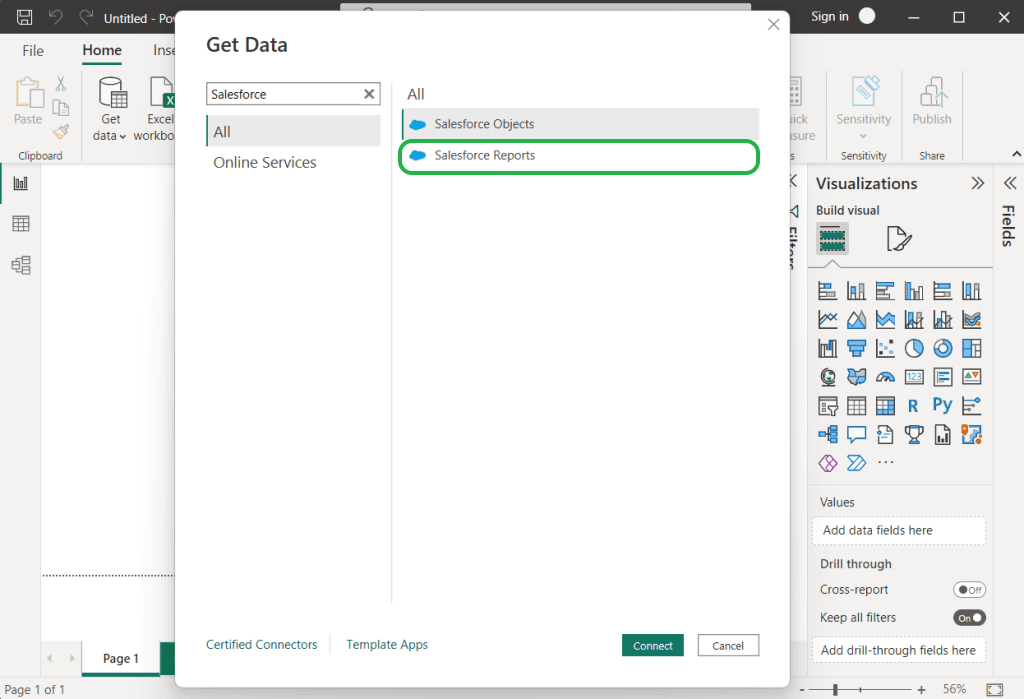
Who It’s For
- Business users and managers who want quick insights using the reports they already have in Salesforce.
- Teams that don’t need to transform or merge data from multiple objects.
- Users who value simplicity and speed over flexibility and customization.
Step-by-Step Instructions
Follow these steps to perform integration with Salesforce Reports:
- Open Power BI and click Get Data.
- From the search box, type Salesforce and select Salesforce Reports.
- Select Production.
- Open Salesforce and log in to your account.
- Click Connect.
- Select the Salesforce object you wish to import to Power BI for data visualization.
Limitations
- Power BI can only import up to 2000 rows from a Salesforce report, which severely restricts large datasets or detailed analysis.
- Since you’re pulling in pre-built Salesforce reports, the data is already prepared, meaning you can’t transform the structure easily.
- You can’t combine multiple reports or connect to other data sources as seamlessly as you can with the Salesforce Objects connector.
- Dependency on Salesforce report setup. If a report isn’t configured correctly in Salesforce, Power BI can only show what’s already available there.
Method 3: Connect Salesforce to Power BI with Salesforce Data Loader
Salesforce Data Loader is a client application provided by Salesforce that lets you export data from your Salesforce org to flat files (like CSVs), which can then be imported into Power BI. It’s useful for bulk data operations, providing complete control over what data you export and when.
Who It’s For
- Users or teams who want complete control over exported data.
- Teams that only need scheduled or ad-hoc updates (e.g., daily or weekly reports).
- Users working in secure environments where local data handling is required.
- Organizations that don’t need complex transformations or live dashboards.
Step-by-Step Instructions
- Download and install Salesforce Data Loader (desktop version) from Salesforce Setup.
- Log in using your Salesforce credentials (ensure API access is enabled).
- Choose the Export.
- Select the objects you want to export.
- Apply filters or SOQL queries if needed to refine your dataset.
- Export the data as a CSV file.
- Open Power BI Desktop, click Get Data, and choose Text/CSV as the source.
- Load and model your data for analysis.
Limitations
- Unless you automate Data Loader with scripts or use a scheduler, exports must be triggered manually.
- This method works with static snapshots, not live data feeds.
- You’ll often need to clean and format the CSV files before importing them into Power BI.
- Data Loader must be downloaded and installed manually.
Note: If you prefer a cloud-based solution with no installation, Skyvia offers a Data Loader for Salesforce that works directly in your browser. It allows you to export Salesforce data to cloud storage or databases, and schedule syncs — all through an intuitive, no-code interface. This is an excellent option for teams looking for more automation without managing local software.
Method 4: Connecting via Salesforce APIs
This method involves fully custom integration via API. Salesforce offers several APIs for accessing CRM data:
- REST API – Light and broadly used for real-time Salesforce data access.
- SOAP API – More structured and enterprise-focused, used for operations that require strict data typing.
- Bulk API 2.0 – Optimized for large-volume data transfers, ideal for exporting millions of records.
By using these APIs, developers can build scripts or applications that extract specific Salesforce data into a database or file, which Power BI can then connect to for visualization.
Who It’s For
- Organizations with in-house developers or data engineers who are comfortable working with APIs.
- Teams that need custom workflows, data filtering, or transformation before the data reaches Power BI.
- Businesses with strict control over data handling, scheduling, and storage requirements.
- Use cases involving very large datasets and advanced data integration scenarios.
Step-by-Step Instructions
- Use a client library (e.g., Python’s simple-salesforce) to query data from Salesforce via the REST API.
- Export the data to a CSV file or write it directly to a SQL-based database.
- In Power BI, use the CSV or database connector to load and visualize the extracted data.
- Automate the entire workflow with scripts and schedulers for recurring data syncs.
from simple_salesforce import Salesforce\n
sf = Salesforce(instance='yourdomain.salesforce.com', session_id='your_access_token')\n
data = sf.query("SELECT Id, Email, LastName, FirstName FROM Contact")By executing this script, you can load Salesforce contacts to your database. Aside from Salesforce contacts, there are more objects that are accessible through this Python library. Then, Power BI can connect to your database for data visualization. Note that you need to use a database where Power BI has a connector (like SQL Server, PostgreSQL, or MySQL).
Limitations
- The method requires technical expertise for setting up API connections, managing authentication, and handling data formats etc.
- Unlike plug-and-play connectors, API integrations must be coded, tested, and updated over time.
- Each Salesforce org has a limited number of API calls per 24-hour period. If exceeded, integrations will fail until the limit resets.
- No native Power BI refresh unless tied to a database or automated workflow. You need to manage your own pipeline to ensure data stays current.
Method 5: Integrating Salesforce and Power BI using Skyvia Connect
Skyvia is a no-code cloud data integration platform that lets you automate flows of data between Salesforce and a wide range of destinations, including Power BI. Skyvia is a smart alternative if you need more flexibility, scalability, or control over your Salesforce to Power BI integration.
Connect is a tool that allows you to publish your Salesforce data as an OData endpoint. You can use this endpoint as a source for Power BI. Skyvia Connect acts as a secure bridge between Salesforce and Power BI, giving you real-time access to CRM data from within your BI environment.
Who It’s For
- Business intelligence teams that need live Salesforce data in Power BI without building complex API pipelines.
- Organizations with strict security policies. You can filter what data to publish and limit access for users.
- Analysts and data engineers who look for real-time integration.
- Businesses using multiple data consumers or other BI tools that can all connect to the same OData endpoint.
Step-by-Step Instructions
- Create Connection to Salesforce.
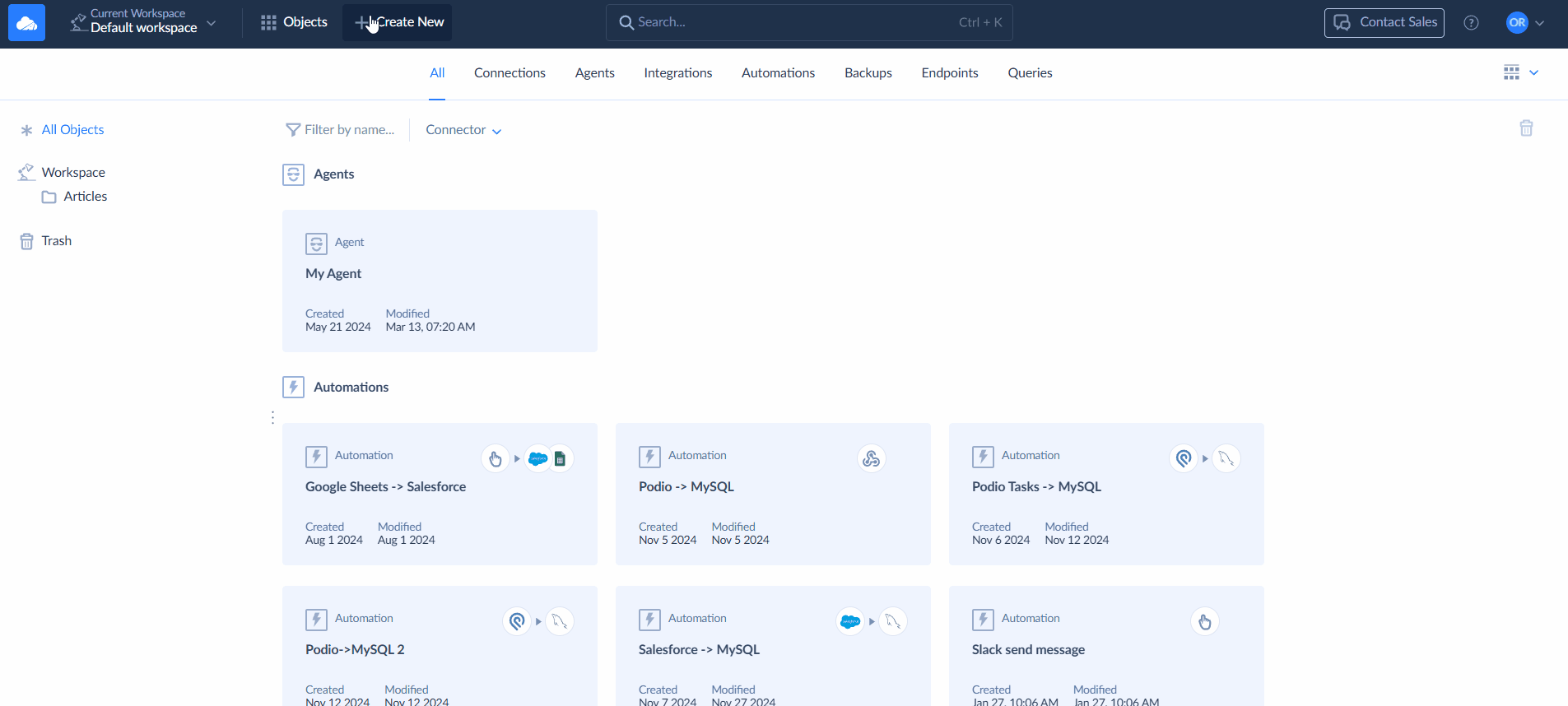
- Sign in to your Salesforce account and save the connection.
- Create an OData endpoint and copy its URL.

- Open Power BI, click Get Data, and choose OData feed as the source.
- Load and model your data for analysis.
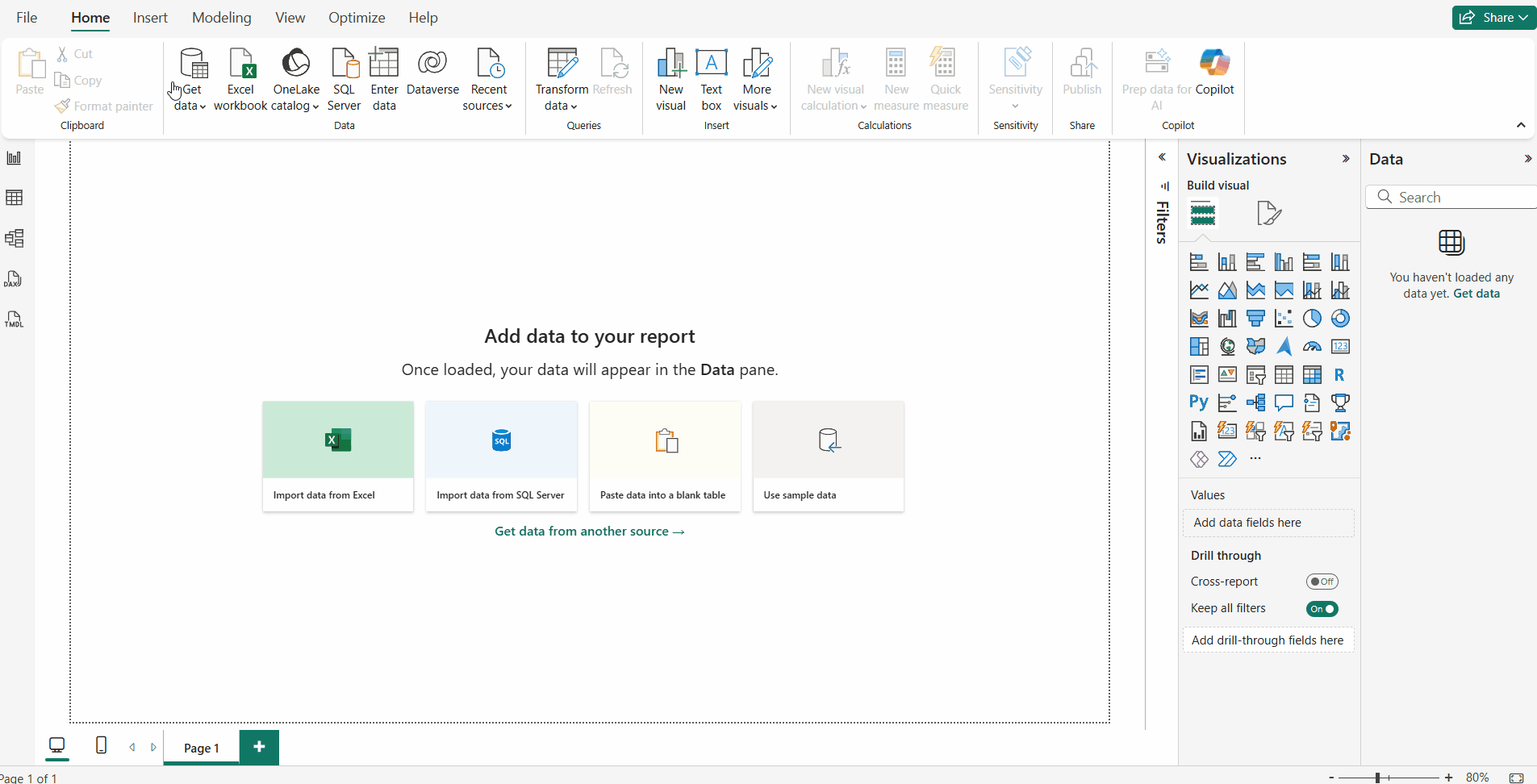
Limitations
- Querying large Salesforce datasets through OData may affect performance.
- Since it’s a live connection, dashboards rely on stable connectivity for consistent performance.
- Skyvia Connect is designed for data access, not data modification, which is fine for analytics but limits writeback scenarios.
Method 6: Connect Salesforce to Power BI Using Skyvia Replication
Another way to connect Power BI and Salesforce is by using Skyvia. This method allows you to extract, transform, and load (ETL) Salesforce data into a database or data warehouse (like SQL Server, Azure, or Google BigQuery or other) and use this database as a source for Power BI.
Skyvia copies the source objects and data structure to a database and keeps them up-to-date if necessary. The method’s key advantages are the following:
Who It’s For
- This approach is handy when working with large datasets, complex transformations, or diverse data sources. Unlike the native Salesforce Reports connector, third-party tools can handle large data volumes.
- Automated data sync. With Skyvia, you can schedule data transfers so your Power BI dashboards stay up-to-date without manual intervention.
- Skyvia supports connections to 200+ cloud and on-premise data sources. You can connect data from several apps and get insights from a consolidated source.
- Advanced data transformation options. Clean, filter, and shape your data before it ever reaches Power BI.
- With tools like Skyvia, you don’t need to write scripts or manage infrastructure.
Who It’s For
- Teams and individuals who need to integrate Salesforce with other platforms (marketing, finance, operations, etc.).
- Mid to large-sized businesses that deal with high data volumes and complex workflows, and require scheduled, reliable syncs.
- Users who want to automate data flows and reduce manual intervention entirely.
- Organizations without in-house developers, thanks to Skyvia’s no-code UI.
Step-by-Step Guide
- Create a connection to Salesforce.
- Connect to a database or data warehouse you want to use, for example, SQL Server, Snowflake, or others.

- Create a new replication. Select Salesforce as Source and the database or data warehouse as Target.
- Select what objects to replicate.

- Set a schedule or run the integration manually.
- After the data is copied, go to Power BI and click Get data.
- Select the desired database or data warehouse from the list of available sources.
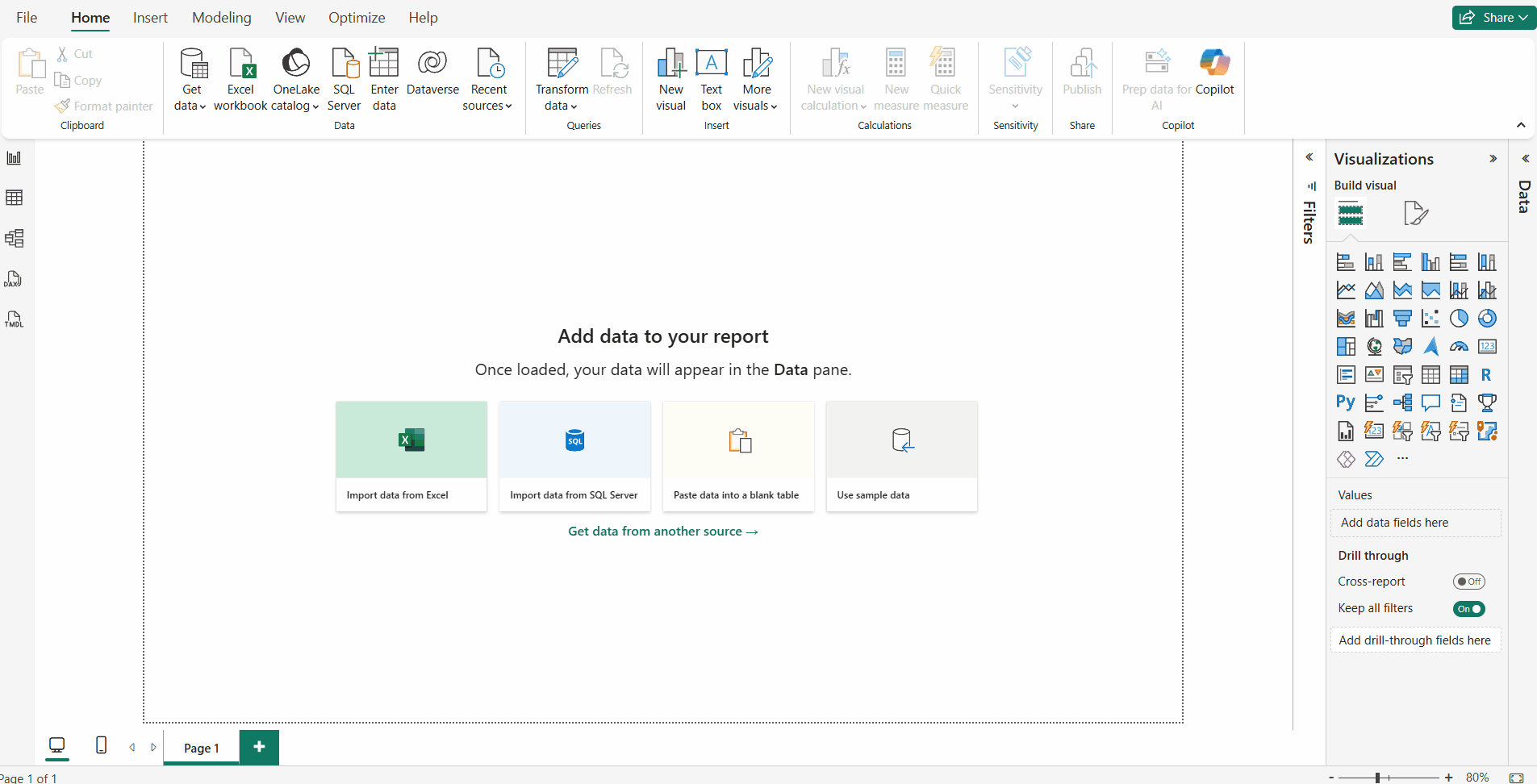
- Enter the server name, required credentials, and select the desired tables.
Limitations
- Initial setup requires planning. While user-friendly, defining your replication, transformation, or connection logic takes upfront time, especially if integrating multiple systems.
- Unlike live connections, Skyvia syncs run on a schedule (e.g., hourly, daily, every 5 minutes), so the data is updated near real time, but not live.
- Some features require paid plans. While Skyvia has a generous free tier, advanced features like high-frequency syncs or a larger number of scheduled integrations may require a subscription.
Method 7: Embedding Power BI in Salesforce
Power BI dashboards don’t need to be standalone since it’s possible to add them directly into your CRM system. That way, a sales team doesn’t need to obtain access to the BI platform every time they need to track specific metrics or explore the funnel effectiveness.
With this method, you can embed interactive Power BI reports inside the Salesforce interface, giving users real-time insights right where they work. This is typically done by embedding Power BI content in Salesforce via an iframe or a custom Lightning component that links to Power BI reports hosted in the Power BI Service (Pro or Premium workspace).
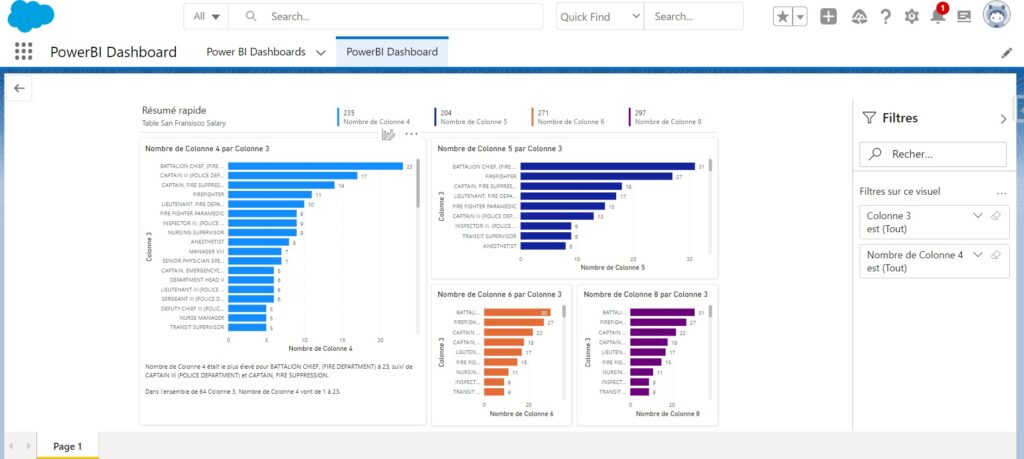
Who It’s For
- Sales and service teams who spend most of their time in Salesforce but need quick access to dashboards and KPIs.
- Managers and decision-makers who want to monitor performance or pipeline data in real time within the CRM.
- Organizations focused on boosting analytics adoption without training users to navigate another platform.
Step-by-Step Instructions
You can add the reports generated by Power BI in Salesforce by following the instructions below.
- Create a Single Page Application in your Salesforce developer account. This solution needs to ask for Power BI credentials to log in. Signed-in customers can view and interact with the embedded content according to their Power BI permissions.
- Make sure to implement the client-side libraries in your application. Use the Power BI embedded analytics Client APIs.
- Utilize the SalesforceUserOwnsDataEmbedding GitHub repository to embed Power BI content into your Salesforce app.
- Use the Power BI JavaScript APIs to pass parameters to Power BI reports and filter them. Feel free to refer to a detailed setup on embedding Power BI in Salesforce.
Limitations
- This method requires a Power BI Pro license (or the report must be hosted in a Premium workspace). Without the proper license, users won’t be able to view the embedded content.
- Embedded reports are limited compared to using Power BI separately. For example, embedding doesn’t allow you to drill through or apply filters dynamically based on Salesforce records.
- Embedding doesn't establish a data pipeline between Salesforce and Power BI. For data to stay fresh, it must be regularly updated in Power BI via other integration methods.
- Embedding requires configuring secure iframes, access tokens, or embedding URLs, and possibly creating custom Lightning components. This may require help from Salesforce admins or developers.
- Depending on how it's implemented, the embedded Power BI dashboards may not scale perfectly on all devices or integrate smoothly with mobile Salesforce apps.
Key Limitations of Power BI – Salesforce Integration
Integrating Salesforce with Power BI unlocks powerful analytics, but it’s not without challenges. Whether you're using native connectors, APIs, or third-party tools, there are some key limitations to keep in mind.
Salesforce API Limits
Most integration methods, including native Power BI connectors and custom API pipelines, rely on Salesforce’s APIs to pull data. However, Salesforce enforces daily API call limits based on your edition and user licenses. Hitting that limit can block further data refreshes until the next cycle, which impacts dashboard freshness and real-time reporting.
Note: Some third-party ETL tools like Skyvia Replication avoid real-time API bottlenecks by syncing data to a database incrementally or on a controlled schedule.
Data Governance and Security
When connecting Salesforce to Power BI, especially through custom scripts or third-party platforms, it’s critical to consider data governance policies, compliance requirements, and access controls.
- Ensure role-based access is enforced so that sensitive data is only visible to authorized users.
- Use secure authentication methods, like OAuth or token-based access.
- Consider data residency and privacy regulations if you're moving data across platforms or regions.
Salesforce Trial Account Limitations
Salesforce trial accounts often do not include full API access, which means native Power BI connectors and API-based tools may not function properly in a test environment. If you're experimenting with integration, be aware that some features may be limited or unavailable until you switch to a paid Salesforce plan with API access enabled.
There’s no one-size-fits-all solution when it comes to integrating Salesforce with Power BI — it all depends on your team’s technical expertise, reporting needs, and data volume.
Conclusion
Now that you are aware of all the possible methods to make Salesforce and Power BI talk to each other, how do you make a well-aimed decision? Here’s a quick recap of your options:
- Just getting started or need a quick solution? Use the Salesforce Reports connector to pull in pre-built reports. It’s simple, but keep in mind the 2,000-row limit and limited flexibility.
- Need deeper access to raw data? Go with the Salesforce Objects connector. It offers more control, but requires a solid understanding of Salesforce’s data model.
- Looking for scalability, automation, and ease of use without code? A third-party tool like Skyvia is the best fit. With Skyvia Connect, you get live OData access. With Skyvia Replication, you can automate ETL processes to your database of choice. Either way, you skip the manual work and API headaches.
- Have in-house developers and complex needs? Use the Salesforce APIs for complete control. This method gives you maximum flexibility but demands time, expertise, and ongoing maintenance.
- Want to keep insights where your team works? Embed Power BI directly into Salesforce to bring real-time dashboards into the CRM, improving adoption and giving users data in context.
Each method has its pros and cons, but if you're looking for the smartest balance of power, simplicity, and performance, Skyvia stands out. It eliminates technical barriers, handles large data volumes, supports scheduling, and doesn’t require writing a single line of code.
Ready to simplify your Salesforce–Power BI integration? Try Skyvia and see how effortless your analytics pipeline can be.